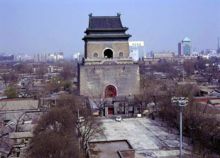Bell and Drum Towers
The bell and drum were originally used as musical instruments in China. Afterward, however, they were used for telling time. As early as in the Han Dynasty (206 BC-220), there was 'a morning bell and a dusk drum'. Telling the time by bell and drum played an important role in helping people live and work regularly when there was no other means to keep track of the time. As a result, bell and drum towers became public architectures, and were widely constructed in almost every city throughout the country since the Han Dynasty. In the history of their construction, the bell and drum towers of Beijing are the largest and highest. Their layout is unique, in that they were placed fore-and-aft, not as the traditional sense of standing right-and-left horizontally.
Lying to the north of Beijing-south axis line in Dongcheng District, the bell and drum towers are visibly prominent constructions and represent the symbol of this old city. They were built in 1272, and rebuilt twice after two fires. At one period in history they were the time-telling center of the capital city during the Yuan, Ming and Qing Dynasties (1271-1911).
Bell Tower
This brick and stone towers have two floors: there is an arched door on all four sides of the tower on the first floor, and you can go up to the second floor through stone stairs. The same exists on the first floor. An arched door was also built on the four sides of the second floor. Additionally, there is a stone window on each side of the four doors. Hanging on an eight-square wooden frame of the second floor, the bell in this tower is the largest and heaviest in China. It is 7.02 meters (23 feet) high including the pendants, with a weight of 63 tons (138,891 pounds). The bell was made of copper, and you can hear its round and clear sound from far away. The two 2-meter-long (2 yards) wooden logs hanging sideward are used to ring the bell.
Drum Tower
Located 100 meters (109 yards) south to the bell tower, the drum tower was placed on a 4-meter-high (13 feet) stone and brick base. It is 46.7 meters (153 feet) high, a little bit lower than the bell tower that is 47.9 meters high (157 feet). This tower is also a two-storey building; the first floor contains the China Committee for the Promotion of the Minority Art. The second floor contains the exhibition area. Originally, there was one big drum and 24 smaller drums, but only the big drum remains. The method of beating the drum is to beat it quickly for 18 times and then slowly for 18 times. Altogether there are three rounds and 108 tollings. People knock the bell and the drum 108 times, because 108 times represent one year in ancient times.
Telling time by ringing the bell and beating the drum was abolished after Pu Yi, the last emperor of China, left the Forbidden City. Since the New Year's Eve of 1990, the sweet sound of the bell that had disappeared for a long time began to ring out in Beijing. Being drowsy for nearly a century, the drum was also beaten again on the New Year's Eve of 2001. It has been beaten four times a day, for 15 minutes at a time since January 1st in 2002. From then on, every New Year Eve, the drum is beaten with the bell 108 times to send a blessing to the people.
The area of the bell and drum towers has been flourishing since the Yuan Dynasty (1271-1368), when they were just standing behind the imperial palace. It was the busy downtown district there then, full of storefronts and businesses. Thanks to the further developing of the businesses, the street in front of the drum tower became the busiest shopping street in the Ming (1368-1644) and Qing (1644-1911) Dynasties. During the Republican Period of China (1911-1949), many have-nots (impoverished people),along with merchants selling handcrafted items (handicraftsmen) and vendors selling snacks and local food items (snack stands) swarmed the place between the bell and drum towers, which attracted people from all walks of life at that time.Today, when visiting, you can climb onto the bell tower and drum towers to have a birds-eye view to admire the entire city, and even take part in the activity of knocking the bell and drum, appreciating all kinds of folk-customs, such as the dragon and lion dance, and other folk-custom exhibitions.
